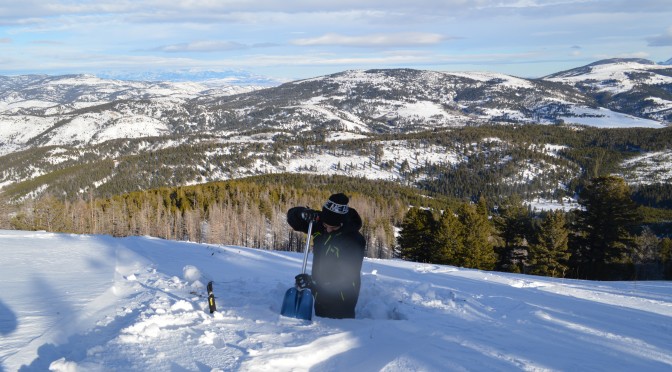Why snow-stability tests matter.
by Doug Chabot
An online article posted October 29, 2015 for backcountrymagazine.com on snowpits, avalanche character, and the difficulties and risks of traveling in various types of snow, is a welcome early season jump-start to get us thinking about snow and avalanches. Every snow climate is different and every professional forecaster looks at the snowpack through his and her own forecasting lens, but we are all trying to increase the understanding of avalanches in order have fun and stay alive. Whether this is your first year at MSU or you’re a super senior, this info is vital if you’re traveling in the backcountry.
After reading Drew Hardesty’s article, ”Mountain Skills: Understanding the ‘Avalanche Problem’“, I wanted to add to the discussion by fine-tuning the message and challenging some of the assumptions. Describing how digging snowpits does not make us immune to triggering avalanches the author writes, “Sometimes, it’s like wearing your seatbelt during a head-on with a Mack truck.” Even so, I always fasten my seatbelt. On a highway of Mack trucks, buckling up seems like a safe bet. He opens the article with a compelling story about skiers triggering a slide that killed one.
Most of the party had been through a Level 1 avalanche class; they had checked the forecast—moderate—dug a pit and made a plan to ski one at a time. Then, they watched with horror as the first skier threw in a ski cut that triggered an avalanche two- to four-feet deep and 600-feet wide.
A paragraph later Drew lists what they did right and wrong:
What are the things the group did that didn’t matter?
1. They dug a snow pit.
Digging a snowpit always matters. It’s the only way to know what’s under our feet at that particular moment. There is no other way.
Snowpit tests are used to show instability, not stability. Never stability. Snowpits do not give the green light to ski; they just give us the red light to not ski. An unstable test result is always critical information. A stable test result does not mean the snow is stable a hundred feet away.
In the article’s example the group read the avalanche forecast, saw no obvious signs of instability and had no reason to suspect the slope. Nonetheless, before dropping in they did the correct thing and dug a snowpit. Although we make our best educated guess on where to dig and test it’s unlikely that it ends up being on the weakest part of the slope. Finding the weakest spot is a combination of luck, instinct and experience. In this case, because the slope avalanched we can infer that a test at the trigger point would have given an unstable result, although it might not have been feasible to do so.
The premise of snowpits not mattering is erroneous. Wearing a seatbelt but arriving unscathed does not mean it was foolhardy to wear one; placing climbing gear in a crack but not falling is neither foolhardy nor pointless; looking at the weather before a big alpine endeavor was not a waste of time because the forecast was wrong. Determining snow stability is not an exact science. Doing the right steps, like snowpit testing, does not always give the correct information. Sometimes people get in an accident while wearing a seatbelt, just as skiers sometimes trigger a slide after doing a stability test. Although wearing a seatbelt or doing a stability test is not going to prevent all mishaps from occurring, taking these precautions increases our margin of safety and could avoid disaster.
This article originally appeared on the Gallatin National Forest Avalanche Center (GNFAC) website. Doug Chabot is the director of the GNFAC.


